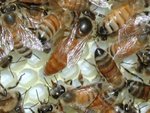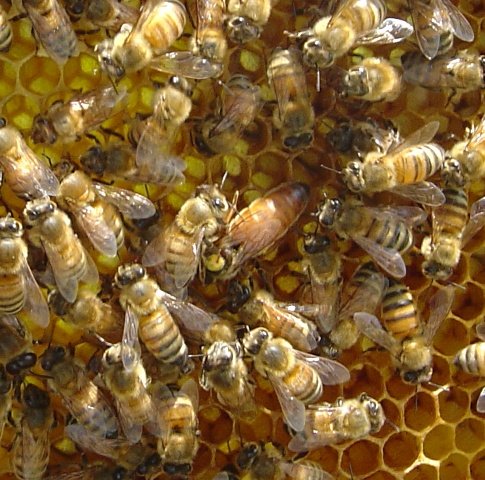The weather was warm enough (low 60’s) to open up the hives and have a more detailed look inside, as well as doing some basic hive maintenance like cleaning off the bottom boards of dead bees and miscellaneous hive debris.

As expected I opened one of the hives to find a family of mice living inside the bottom hive body. A hive is a nice dry place for mice to live during the winter. The bees stay in the upper box, to far away to do much damage to mice during the cold winter months. It appears that my home made mouse guards, which are supposed to keep the mice out, did not work the way they were intended to. I ended up replacing three of the four chewed combs with drawn comb from last season.
 The Crocus have started blooming and there were some bees working the welcomed flowers. Pollen collection seamed to be the task of the day. Pollen is consumed by the bees as their carbohydrate. Mixed with some honey this “Bee Bread” is fed to the young while they develop through their various stages from egg to adult. Pollen is crucial to the spring buildup of the hive. An over-wintered hive will expand from around 4,000 bees in the spring to about 60,000 bees in August. The number of bees in the hive has a direct effect the amount of nectar collected by the bees from the flowers, and thus the amount of honey which will be produced that summer.
The Crocus have started blooming and there were some bees working the welcomed flowers. Pollen collection seamed to be the task of the day. Pollen is consumed by the bees as their carbohydrate. Mixed with some honey this “Bee Bread” is fed to the young while they develop through their various stages from egg to adult. Pollen is crucial to the spring buildup of the hive. An over-wintered hive will expand from around 4,000 bees in the spring to about 60,000 bees in August. The number of bees in the hive has a direct effect the amount of nectar collected by the bees from the flowers, and thus the amount of honey which will be produced that summer.  A retro-fitted bottom board. Once solid it has been modified to be a screened bottom board with a pull-out sticky board.
A retro-fitted bottom board. Once solid it has been modified to be a screened bottom board with a pull-out sticky board.It has been a cold spring here on Cape Cod. The bees have not yet started feeding off the sugar syrup placed in the hive top feeders two weeks ago. Once the warmer spring weather appears the bees will kick into high gear raising and feeding the young larva.
I would be interested to hear from other northern beekeepers regarding the condition of their hives. What are you doing to feed and help you bees?
You can leave a comment by selecting “post a comment” below.
You can leave a comment by selecting “post a comment” below.







No comments:
Post a Comment